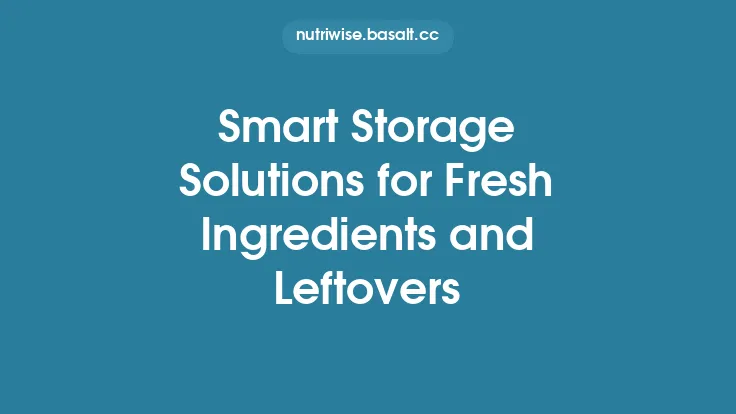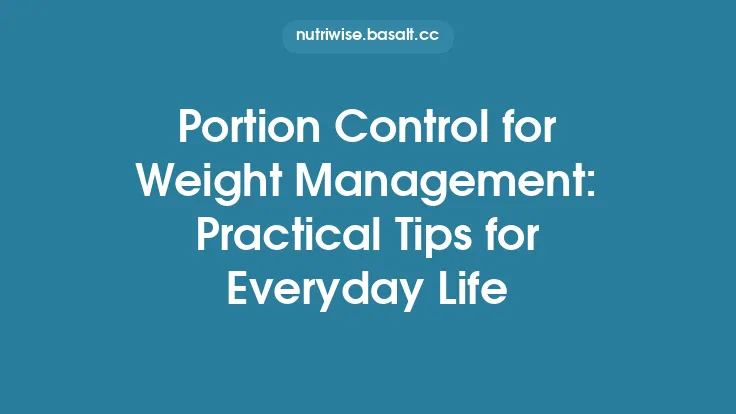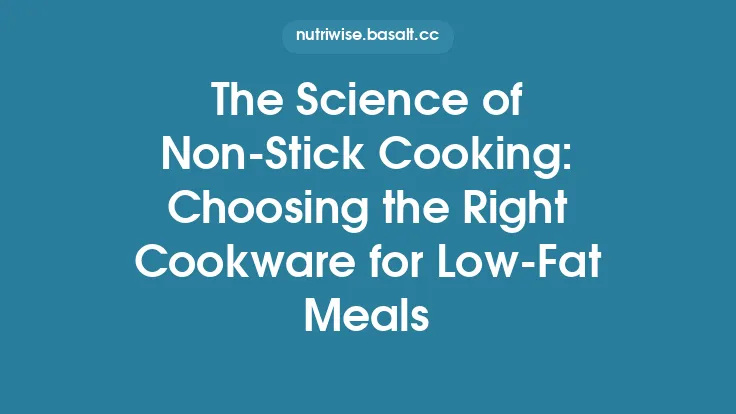Zero‑waste kitchen storage isn’t just a buzzword; it’s a practical framework that lets everyday cooks keep food fresh, organized, and ready to use while dramatically cutting down on disposable packaging. By rethinking how we buy, store, and manage ingredients, we can create a kitchen that works for us and the planet at the same time.
Understanding Zero‑Waste Principles in Kitchen Storage
At its core, zero‑waste storage is about eliminating unnecessary material flow. Rather than focusing on a single product (e.g., a reusable container), the approach looks at the entire lifecycle of food from purchase to consumption. Key principles include:
- Source reduction – buying in bulk or from refill stations to avoid individual packaging.
- Material substitution – opting for durable, recyclable, or compostable materials that can be reused indefinitely.
- System design – arranging storage so that items are visible, accessible, and used before they spoil.
- Closed‑loop thinking – planning for the end‑of‑life of storage tools (e.g., repurposing a jar as a plant pot).
When these ideas are woven into daily routines, waste drops dramatically without sacrificing convenience.
Bulk Buying and Refill Strategies for Minimal Packaging
Purchasing ingredients in larger quantities is one of the most effective ways to cut down on single‑use packaging. Here’s how to make bulk buying work in a typical home kitchen:
| Step | Action | Why it Helps |
|---|---|---|
| 1. Identify Refillable Staples | Grains, legumes, nuts, spices, oils, and cleaning agents are prime candidates. | These items have long shelf lives and are often sold in bulk at co‑ops or grocery refill stations. |
| 2. Use Dedicated Bulk Containers | Keep a set of sturdy, food‑grade containers (stainless steel, BPA‑free silicone, or thick glass) on the countertop for immediate transfer. | Prevents the need for disposable bags or boxes at the point of purchase. |
| 3. Implement a “First‑In, First‑Out” (FIFO) System | Rotate older stock to the front and place new purchases behind. | Reduces the chance of food expiring before it’s used. |
| 4. Track Quantities Digitally | Simple spreadsheet or pantry‑management app can log weight/volume of each bulk item. | Helps you buy only what you need, avoiding over‑stocking. |
By integrating these steps, you turn bulk buying from a occasional habit into a seamless part of weekly shopping.
Upcycled and Repurposed Storage Options
The kitchen already contains a treasure trove of containers that can be given a second life:
- Glass milk bottles – once emptied, they make excellent pour‑spouts for oils, vinegars, or homemade sauces. Their narrow neck helps control flow and reduces drips.
- Mason jars with original lids – perfect for dry goods, layered salads, or even as makeshift spice dispensers when fitted with a drilled lid and a small funnel.
- Tin cans – after thorough cleaning, they become compact storage for pantry staples like tea bags, dried herbs, or even as mini compost bins for coffee grounds.
- Silicone baking mats – cut into smaller squares to line small containers, providing a reusable, non‑stick surface for sticky items like honey or jam.
When repurposing, always ensure the material is food‑safe, free of residues, and properly sanitized (hot water, dish soap, and a final rinse in boiling water for glass or metal).
Innovative Materials: Stainless Steel, Silicone, Bamboo, and Stone
Beyond upcycling, modern material science offers several durable alternatives that align with zero‑waste goals:
- Stainless steel – non‑reactive, corrosion‑resistant, and virtually indestructible. Ideal for bulk storage of dry goods, as well as for insulated containers that keep soups or stews hot for hours.
- Food‑grade silicone – flexible, heat‑resistant up to 260 °C (500 °F), and collapsible for space‑saving storage. Silicone lids can replace cling film on bowls, and silicone bags serve as reusable alternatives to zip‑lock bags.
- Bamboo – renewable and naturally antimicrobial. Bamboo drawer dividers, cutting boards, and small containers add a rustic aesthetic while providing sturdy, biodegradable options.
- Stoneware – dense ceramic that maintains temperature and offers excellent airtightness when paired with a fitted lid. Stoneware crocks are especially useful for fermenting vegetables, a storage method discussed later.
Each material brings a unique set of properties; selecting the right one depends on the food type, temperature range, and frequency of use.
Modular and Stackable Systems for Efficient Space Use
A well‑designed storage system reduces the need for extra containers because it maximizes the utility of what you already have. Consider these design strategies:
- Uniform dimensions – Choose containers that share the same width and depth, allowing them to nest or stack without wasted gaps.
- Interlocking lids – Some silicone or stainless‑steel sets feature lids that double as trays, creating a “nest‑and‑stack” configuration.
- Adjustable dividers – Bamboo or acrylic dividers that slide within a larger bin let you reconfigure space for different ingredient sizes.
- Pull‑out pantry shelves – Sliding trays bring back‑corner items to the front, encouraging use before they’re forgotten.
By treating storage as a modular system rather than a collection of disparate jars, you reduce the total number of pieces needed and keep the pantry tidy, which in turn reduces food waste.
Airtight Preservation Techniques Without Single‑Use Wraps
Keeping food fresh often hinges on controlling oxygen, moisture, and light. Here are reusable methods that avoid disposable wraps:
- Silicone sealing rings – Placed over the rim of a jar, they create a vacuum‑like seal when pressed down, extending the life of dry goods and leftovers.
- Reusable beeswax‑coated cloths – While technically a DIY wrap, commercially available pre‑coated cloths can be used straight out of the package, offering a zero‑waste alternative to plastic wrap for cheese, bread, and produce.
- Glass or stainless‑steel containers with airtight silicone gaskets – These provide a hermetic seal comparable to commercial vacuum bags but can be opened and closed repeatedly.
- Stone or ceramic crocks with water‑sealed lids – The lid sits in a shallow water bath, creating a moisture barrier that is ideal for fermenting vegetables and storing pickles without plastic.
These techniques maintain freshness while eliminating the need for single‑use films or bags.
Smart Labeling and Inventory Management for Waste Reduction
Even the best storage system fails if you can’t see what’s inside. Sustainable labeling practices keep food moving through the kitchen:
- Reusable chalkboard labels – Small chalkboard stickers adhered to container lids allow you to write the contents and date, then erase and update as needed.
- Magnetic tags – For metal pantry doors, magnetic labels can be moved around, making it easy to reorganize without waste.
- QR‑code inventory sheets – Scan a QR code on a container to pull up a digital log of purchase date, expiration, and suggested recipes. This merges technology with zero‑waste philosophy without adding physical waste.
Consistent labeling prevents “forgotten food” and helps you plan meals around what you already have, cutting both waste and grocery bills.
Integrating Fermentation and Pickling as Storage Methods
Fermentation isn’t just a culinary trend; it’s a natural preservation method that transforms perishable produce into shelf‑stable foods, reducing waste dramatically. Key considerations for a zero‑waste approach:
- Use a single, multi‑purpose fermentation crock – A large stoneware or stainless‑steel crock can handle everything from sauerkraut to kimchi.
- Weight the vegetables with reusable glass or ceramic fermentation weights – These keep produce submerged, preventing mold without disposable plastic bags.
- Seal with a water‑filled lid or a breathable cloth – The water seal creates an anaerobic environment, while a cloth allows gases to escape, both without plastic.
Fermented foods not only last longer but also add nutritional value, making them a win‑win for waste reduction and health.
Energy‑Efficient Cooling and Freezing Practices
Refrigeration and freezing are essential for many ingredients, yet they can be energy‑intensive. Optimize them with zero‑waste thinking:
- Group similar temperature items – Store dairy, meats, and ready‑to‑eat meals together to minimize door openings and maintain a stable internal temperature.
- Use freezer‑safe silicone bags – These replace disposable zip‑lock bags and can be flattened for efficient stacking, reducing the freezer’s workload.
- Pre‑portion before freezing – Portioning into reusable containers means you only thaw what you need, preventing waste from over‑defrosted food.
- Maintain a full but not overloaded freezer – A well‑filled freezer retains cold better, using less energy, while an over‑packed unit restricts airflow and forces the compressor to work harder.
By aligning storage habits with energy‑saving practices, you lower both your carbon footprint and your utility bills.
Maintenance and Longevity of Zero‑Waste Storage Tools
The durability of your storage system determines its overall environmental impact. Regular care extends the life of each piece:
- Stainless steel – Wash with mild detergent, avoid abrasive pads that can scratch the surface, and dry promptly to prevent water spots.
- Silicone – Remove odors by soaking in a solution of warm water and baking soda, then rinse thoroughly.
- Bamboo – Oil lightly with food‑grade mineral oil every few months to prevent cracking and maintain its natural antimicrobial properties.
- Stoneware – Avoid sudden temperature shocks (e.g., placing a hot dish directly into a cold fridge) to prevent cracking.
A simple maintenance routine ensures that each item remains functional for years, amplifying the waste‑reduction benefits.
Community Resources and Sharing Economies for Kitchen Storage
Zero‑waste doesn’t have to be a solo endeavor. Leveraging community networks can further reduce the need for new storage items:
- Tool libraries – Some neighborhoods operate “kitchen tool libraries” where members can borrow bulk containers, fermentation crocks, or specialty storage lids.
- Bulk‑buy co‑ops – Joining a co‑op gives you access to shared bulk bins, reducing the number of individual containers you need to own.
- Online swap groups – Platforms like local Facebook groups or dedicated apps allow you to trade or give away gently used storage items, extending their useful life.
Participating in these ecosystems multiplies the impact of your personal zero‑waste practices and fosters a culture of shared responsibility.
Bringing It All Together
Zero‑waste kitchen storage is a holistic practice that blends thoughtful purchasing, smart material choices, efficient organization, and community engagement. By adopting bulk refill habits, repurposing everyday containers, selecting durable innovative materials, and employing airtight, reusable preservation methods, you create a kitchen that not only minimizes waste but also enhances food quality and reduces costs. The result is a resilient, sustainable cooking environment that supports everyday meals while honoring the planet.





